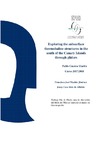Identificador persistente para citar o vincular este elemento:
https://accedacris.ulpgc.es/jspui/handle/10553/74653
| Campo DC | Valor | idioma |
|---|---|---|
| dc.contributor.advisor | Machín Jiménez, Francisco José | - |
| dc.contributor.advisor | Coca Saenz De Albéniz, Josep | - |
| dc.contributor.author | Guerra Martín, Pablo | - |
| dc.date.accessioned | 2020-10-05T13:28:02Z | - |
| dc.date.available | 2020-10-05T13:28:02Z | - |
| dc.date.issued | 2018 | en_US |
| dc.identifier.uri | https://accedacris.ulpgc.es/handle/10553/74653 | - |
| dc.description.abstract | The oceanographic environment of the Canary Islands is strongly influenced by mesoscale phenomena such as the eddies south of the islands, the upwelling filaments in the area closest to the African coast and the lee of the islands of greater relief. Gliders are autonomous underwater vehicles providing high‐resolution hydrographic and biochemical measurements and they are useful to measure more accurately the structures of the environment of the Canary Islands. The study of the lee allows us to analyse a subsurface core in the temperature and density anomaly fields as well as the variability of the isotherms and isopycnal of 20 ºC and 1026 kg/m3 respectively. The core of the warm pool is delimited by a temperature anomaly greater than 1ºC and a negative density anomaly of -0.2 kg/m3, located between 50 and 100-150 m. The wind field south of Gran Canaria has a variable intensity between 4.9±1.2 m/s in the area closest to the island and 10.1±1.1 m/s in notaffected area by the orography of the island. | en_US |
| dc.language | eng | en_US |
| dc.subject | 2510 Oceanografía | en_US |
| dc.subject | 3301 Ingeniería y tecnología aeronáuticas | en_US |
| dc.subject.other | Gliders | en_US |
| dc.subject.other | Canary islands | en_US |
| dc.subject.other | Thermohaline structures | en_US |
| dc.title | Exploring the subsurface thermohaline structures in the south of the Canary Islands through gliders | en_US |
| dc.type | info:eu-repo/semantics/masterThesis | en_US |
| dc.type | MasterThesis | en_US |
| dc.contributor.departamento | Departamento de Física | en_US |
| dc.contributor.facultad | Facultad de Ciencias del Mar | en_US |
| dc.investigacion | Ciencias | en_US |
| dc.type2 | Trabajo final de máster | en_US |
| dc.description.notas | Máster en Oceanografía ; 2017-2018 | en_US |
| dc.utils.revision | Sí | en_US |
| dc.identifier.matricula | TFT-46481 | es |
| dc.identifier.ulpgc | Sí | en_US |
| dc.contributor.buulpgc | BU-BAS | en_US |
| dc.contributor.titulacion | Máster Universitario en Oceanografía por la Universidad de Cádiz, la Universidad de Las Palmas de Gran Canaria y la Universidad de Vigo | es |
| item.grantfulltext | restricted | - |
| item.fulltext | Con texto completo | - |
| crisitem.advisor.dept | GIR ECOAQUA: Oceanografía Física y Geofísica Aplicada | - |
| crisitem.advisor.dept | IU de Investigación en Acuicultura Sostenible y Ec | - |
| crisitem.advisor.dept | Departamento de Física | - |
| crisitem.advisor.dept | GIR ECOAQUA: Biodiversidad y Conservación | - |
| crisitem.advisor.dept | IU de Investigación en Acuicultura Sostenible y Ec | - |
| crisitem.author.dept | GIR ECOAQUA: Oceanografía Física y Geofísica Aplicada | - |
| crisitem.author.dept | IU de Investigación en Acuicultura Sostenible y Ec | - |
| crisitem.author.parentorg | IU de Investigación en Acuicultura Sostenible y Ec | - |
| crisitem.author.fullName | Guerra Martín,Pablo | - |
| Colección: | Trabajo final de máster Restringido ULPGC | |
Visitas
93
actualizado el 20-jul-2024
Descargas
33
actualizado el 20-jul-2024
Google ScholarTM
Verifica
Comparte
Exporta metadatos
Los elementos en ULPGC accedaCRIS están protegidos por derechos de autor con todos los derechos reservados, a menos que se indique lo contrario.
